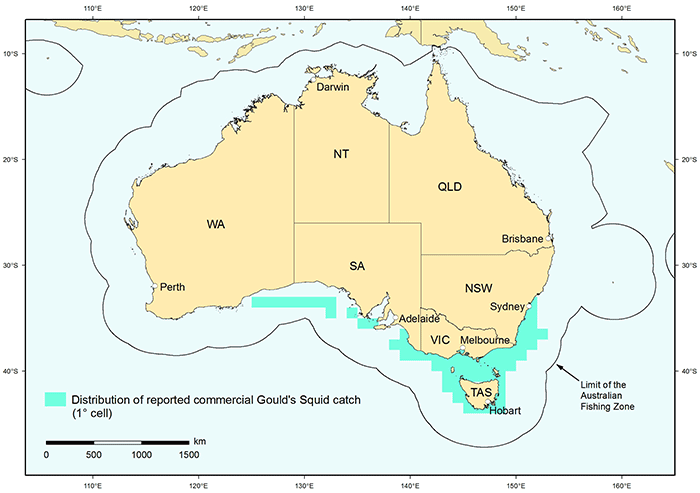Squids have a light, subtle taste and are firm yet tender.
Squid is popularly served as deep fried rings (often called “calamari”).
Download our species guide on common species caught in AFMA managed fisheries.
Gear allowance
| Gear allowance | Fishing Mortality* | Biomass** |
|---|---|---|
|
Gear Allowance 550 squid jigging machines For the 2023 Season |
G;Not subject to overfishing | G;Not overfished |
* Fishing mortality status relates to the level of fishing pressure on a stock - specifically, whether fishing mortality in the year being assessed is likely to result in the stock becoming overfished or prevent the stock from rebuilding from an overfished state. If fishing mortality exceeds either of these thresholds, a stock is considered to be subject to overfishing.
** Biomass status relates to how many fish there are - specifically, whether the biomass in the year being assessed is above the level at which the risk to the stock is considered to be unacceptable. The HSP defines this level as the limit reference point, below which the stock is considered to be overfished.
Scientific name: Nototodarus gouldi
Family: Ommastrephidae
Other names: Aeroplane squid, aero squid, Gould’s flying squid, arrow squid, torpedo squid
Description: Gould’s squid have a heavily muscled mantle which tapers gradually to the fins, and then sharply to the tail. The fins are wide and triangular. The skin is smooth and light brownish-pink to brick red with a bluish purple dorsal stripe. The cartilage that connects the mantle to the funnel (used in locomotion) is shaped like an inverted ‘T’. Gould’s squid have eight shorter arms and two longer feeding tentacles.
Size (length and weight): Up to a mantle length of 40 cm and 1.6 kg. Commonly found at about 0.7 kg in weight. Females grow larger than males.
Life span: Up to 1 year.
Habitat: Gould’s squid inhabit temperate and subtropical waters of Australia and New Zealand. They can be found in estuaries and pelagic environments to depths of 825 metres. They are most abundant over the continental shelf at depths of 50-200 metres. Larvae and juveniles are often found in shallow coastal waters. Gould’s squid aggregate near the sea bed during the day and move into the water column at night to feed.
Prey: Small fish such as pilchards and barracouta, and pelagic crustaceans. Cannibalism is common in larger individuals.
Predators: Sharks, large fish such as John dory and tunas, birds and marine mammals.
Reproduction: Gould’s squid reach reproductive maturity at an age of 6-9 months. Males mature at a smaller size than females. They spawn throughout the year, with 2‑3 peaks in spawning activity. Females mate before they are fully mature, with sperm bundles (‘spermatophores’) from the male being stored in buccal pouches around the mouth. It is not known how long spermatophores are retained before fertilisation occurs. Eggs are fertilised as they pass the buccal pouch and are released in a free-floating jelly-like mass. Each egg mass can contain several thousand eggs, although reproduction is highly variable depending on environmental conditions. Hatching occurs 1-2 months after fertilisation. Gould’s squid die shortly after spawning.
Other notes: Growth rates have been estimated at up to 4 cm per month in south-eastern Australia.
| Fishery | Gear | Catch of this species is targeted or incidental |
|---|---|---|
| Southern Squid Jig Fishery | Jigging | Targeted |
| Southern and Eastern Scalefish and Shark Fishery – Great Australian Bight Trawl Sector | Trawl | Incidental |
| Southern and Eastern Scalefish and Shark Fishery – Commonwealth Trawl Sector | Trawl | Incidental |
| State managed fisheries, Tasmania Recreational catches | Jigging | Targeted in the Tasmanian Auto Jig sector of the Scalefish Fishery, and incidentally caught commercially by hand held squid jig when targeting southern calamari. Small amount also taken recreationally |
Gould’s squid is managed by a total allowable effort limit and catch trigger limits that are monitored throughout the season. This means there are limits on the number of jigging machines allowed to be used in the fishery for each season. The fishery is managed under a limited entry policy which means that anyone who wants to fish must either lease or purchase an existing permit from another fisher.
The Southern Squid Jig Fishery area of waters is located off New South Wales, Victoria, Tasmania and South Australia, southern Queensland, with the majority of fishing effort taking place off Victoria.
Gould’s squid are targeted by the jigging fleet in waters from 60-120 metres and are also taken as bycatch in the Commonwealth Trawl Sector and the Great Australian Bight Trawl Sector.

Due to the highly selective nature of jigging for squid, bycatch levels and impacts on the marine environment are extremely low. In managing our fisheries we consider the impact that catching each species has on the environment through our ecological risk assessment process.
Gear
Gear allowance
| Species | 2020 gear allowance | 2020 hours fished | 2021 gear allowance | 2021 hours fished | 2022 gear allowance | 2022 hours fished |
| Gould’s squid | 550 standard squid jigging machines | 1711 | 550 standard squid jigging machines | 3201 | 550 standard squid jigging machines | 1320 |
GVP
$A 1.5 million (2020–21).
Want to know more?
This is just an overview of Gould’s squid, if you want to know more see the links below.
This fish is managed under the Southern Squid Jig Fishery.
- See the most recent Fishery status report
- Download raw data on annual catches from AFMA catch disposal records and AFMA daily fishing logbooks
- Southern Squid Jig Fishery Resource Assessment Group
- South East Management Advisory Committee
- Bycatch and discard program
- Visit the FRDC Fishfiles website for the best cooking techniques and recipes for this fish